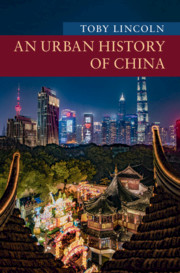Book contents
- An Urban History of China
- New Approaches to Asian History
- An Urban History of China
- Copyright page
- Contents
- Figures
- Maps
- Tables
- Acknowledgements
- Introduction
- 1 The Emergence of China’s Imperial Urban Civilization (Antiquity to 220 CE)
- 2 The Expansion of China’s Imperial Urban Civilization to the South (220–755)
- 3 The Tang-Song Transition and Its Effects on China’s Imperial Urban Civilization (907–1402)
- 4 The Flowering of Chinese Imperial Urban Civilization (1402–1799)
- 5 The Seeds of Urban Modernity (1800–1895)
- 6 Urban Modernity in Republican China (1895–1949)
- 7 The Maoist Period (1949–1976)
- 8 The Reform Era and the Present
- Conclusion
- Index
- Series page
- References
1 - The Emergence of China’s Imperial Urban Civilization (Antiquity to 220 CE)
Published online by Cambridge University Press: 29 April 2021
- An Urban History of China
- New Approaches to Asian History
- An Urban History of China
- Copyright page
- Contents
- Figures
- Maps
- Tables
- Acknowledgements
- Introduction
- 1 The Emergence of China’s Imperial Urban Civilization (Antiquity to 220 CE)
- 2 The Expansion of China’s Imperial Urban Civilization to the South (220–755)
- 3 The Tang-Song Transition and Its Effects on China’s Imperial Urban Civilization (907–1402)
- 4 The Flowering of Chinese Imperial Urban Civilization (1402–1799)
- 5 The Seeds of Urban Modernity (1800–1895)
- 6 Urban Modernity in Republican China (1895–1949)
- 7 The Maoist Period (1949–1976)
- 8 The Reform Era and the Present
- Conclusion
- Index
- Series page
- References
Summary
The chapter describes how the Chinese imperial urban civilization emerged. The urban system developed from a loosely linked collection of cities into an imperial network with the main capital, Chang’an, as the political, economic, and cultural centre. Roads and waterways allowed goods and people to move around the empire, and trading routes to the west linked China to central Asia and beyond. From their origins as small settlements with earthen walls, Chinese cities developed according to prescribed plans that linked imperial power on earth with divine power in heaven. These were set out in the Record of Investigation of Crafts (Kaogongji), an ancient Chinese text. Chinese cities became nodes in an imperial bureaucracy, and although there was no autonomous municipal government, in Chang’an and other capital cities, officials were responsible for urban management. Chinese cities had an urban culture. Kings and emperors lived in their palaces, only emerging to conduct rituals such as sacrifices to ancestors and gods. An imperial administrative elite ran the empire, and merchants, shopkeepers, and artisans traded goods and set up businesses in markets in Chang’an and other cities, which were described in poems that reflected on urban life.
- Type
- Chapter
- Information
- An Urban History of China , pp. 15 - 44Publisher: Cambridge University PressPrint publication year: 2021



